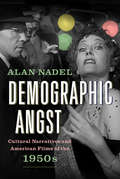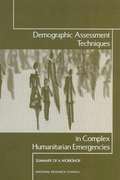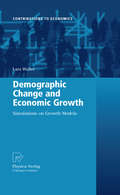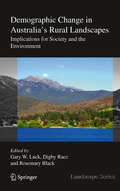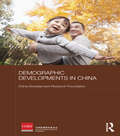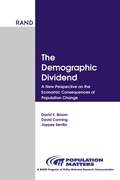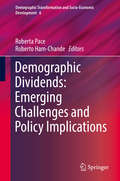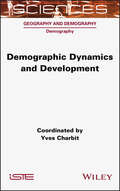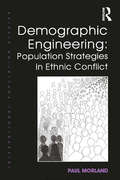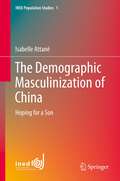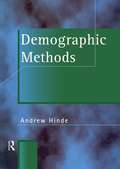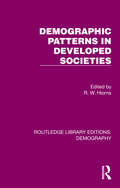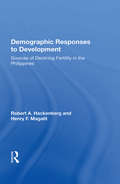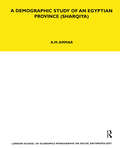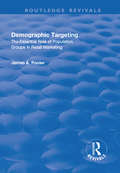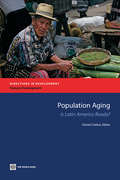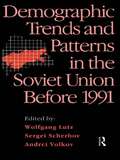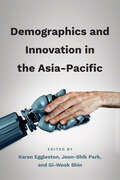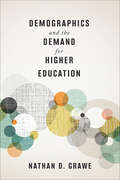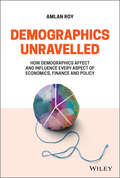- Table View
- List View
Demographic Angst: Cultural Narratives and American Films of the 1950s
by Alan NadelProlific literature, both popular and scholarly, depicts America in the period of the High Cold War as being obsessed with normality, implicitly figuring the postwar period as a return to the way of life that had been put on hold, first by the Great Depression and then by Pearl Harbor. Demographic Angst argues that mandated normativity—as a political agenda and a social ethic—precluded explicit expression of the anxiety produced by America’s radically reconfigured postwar population. Alan Nadel explores influential non-fiction books, magazine articles, and public documents in conjunction with films such as Singin’ in the Rain, On the Waterfront, Sunset Boulevard, and Sayonara, to examine how these films worked through fresh anxieties that emerged during the 1950s.
Demographic Assessment Techniques in Complex Humanitarian Emergencies: SUMMARY OF A WORKSHOP
by Holly ReedA summary of the Demographic Assessment Techniques in Complex Humanitarian Emergencies
Demographic Change and Economic Growth: Simulations on Growth Models
by Lars WeberIn this book the author investigates the impact of demographic change on economic growth. As a result of the current financial crisis, a new view on economics has been demanded by various scientists. The author provides such a new view on economic growth, using a methodology of system dynamics. By applying this method, the author focuses on characteristics of complex systems and analyzes aging and shrinking processes, and not only positive growth. Delays and feedback processes are also considered. This leads to deeper and revealing insights into economic behavior. In doing so, a new semi-endogenous growth model is developed by introducing a specific and detailed population sector (demographic growth model). The book shows and analyzes the behavior of such a model and tests several policy scenarios in a transfer chapter to apply the new theoretical approach on real world problems. The major results are summarized in 15 principles of demographic growth.
Demographic Change and Housing Wealth:
by Kees Dol John Doling Nick Horsewood Hanna Szemzo József Hegedüs Nóra Teller Richard Ronald Marja Elsinga Janneke ToussaintAcross the EU, populations are shrinking and ageing. An increasing burden is being placed on a smaller working population to generate the taxes required for pensions and care costs. Welfare states are weakening in many countries and across Europe, households are being increasingly expected to plan for their retirement and future care needs within this risky environment. At the same time, the proportion of people buying their own home in most countries has risen, so that some two-thirds of European households now own their homes. Housing equity now considerably exceeds total European GDP. This book discusses questions like: to what extent might home ownership provide a potential cure for some of the consequences of ageing populations by realizing housing equity in order to meet the consumption needs of older people? What does this mean for patterns of inheritance and longer-term inequalities across Europe? And to what extent are governments banking on their citizens utilising their housing wealth now and in the future?
Demographic Change in Australia's Rural Landscapes
by Rosemary Black Gary W. Luck Digby RaceThroughout history, humans have lived primarily in rural landscapes. In 2008, for the first time, the global population became predominantly urban. While much research has focussed on the impacts of increasing urbanisation, we have very little knowledge of the implications of these changes for rural landscapes. Global trends suggest populations in rural landscapes are, relatively speaking, in decline. Yet this broad trend is too simplistic and can be very misleading for researchers, land managers and policy makers. This generalisation often masks a much more complex and dynamic process of demographic change, with some rural areas increasing in popularity and experiencing new environmental pressures. The patterns of change can be broadly characterised in two ways: population decline and dissolving rural communities; and amenity-led in-migration (or counter-urbanisation) - a trend identified in developed regions such as North America and Australia. Both of these patterns have substantial implications for the management and sustainability of rural landscapes and communities. This book examines broad and local-scale patterns of demographic change in rural landscapes, identifying some of the drivers of these changes using local case studies, and outlining the implications of changes for society and the environment. The book adopts an interdisciplinary approach by explicitly linking demographic change with environmental, land-use, social and economic factors. The book will provide a useful resource for researchers and graduate students interested in urban development, sustainability science, landscape studies and demographic change, as well as environmental management, human and physical geography and rural sociology.
Demographic Developments in China (Routledge Studies on the Chinese Economy)
by China Development Research FoundationThis book assesses current developments in China’s demography, and discusses the changes which should be implemented to bring policy into line with the current demographic situation. It argues that population planning, which was introduced in the early years of the People’s Republic alongside economic planning, including "the one child policy", is no longer appropriate. It considers the results of the 2010 census, which showed the very significant shifts that are occurring , including a declining rate of population growth, ongoing growth of the number of people in "the floating population", an increasingly imbalanced sex ratio among newborn children, and ongoing ageing of the population. Besides discussing population planning policy, the book also examines how policies in the fields of education, health, gender relations, child development in rural areas, and polices for the elderly and families should be adjusted to accommodate demographic developments.
The Demographic Dividend
by Jaypee Sevilla David Canning David BloomThere is long-standing debate on how population growth affects national economies. A new report from Population Matters examines the history of this debate and synthesizes current research on the topic. The authors, led by Harvard economist David Bloom, conclude that population age structure, more than size or growth per se, affects economic development, and that reducing high fertility can create opportunities for economic growth if the right kinds of educational, health, and labor-market policies are in place. The report also examines specific regions of the world and how their differing policy environments have affected the relationship between population change and economic development.
Demographic Dividends: Emerging Challenges and Policy Implications
by Roberto Ham-Chande Roberta PaceThis book examines potential economic opportunities that countries can experience when fertility rates fall and the average life expectancy of the working age population increases. It presents detailed demographic and economic analysis of middle-income countries throughout the world in order to show how these countries can take advantage of this demographic bonus. The book first traces the common link between policies that contribute to fertility transition as well as create the right kind of environment for reaping the benefit of demographic dividend. Next, it explores different countries and regions who are at different levels of development. It assesses the long term impact of gender equality on economic growth and development in Latin America; describes the life-cycle saving patterns of Mexican households; and examines demographic determinants of economic growth in BRICS. The book also offers demographic and economic analysis of the Mediterranean area, Sub-Saharan Africa, and New Zealand. The comparison between the different territorial contexts allow for the identification of three typologies of demographic dividend: the first dividend, when the working population grows faster than total population, the second dividend, as active generations get older and invest their savings in the production system of their country, and the third dividend, based on the coexistence of two populations age structure strongly contrasting. Overall, this book argues for the need to capitalize on the opportunities that come from the demographic dividend by investing heavily in education programs, training programs for the population working age, health programs, the creation of health insurance systems as well as programs to reduce or increase fertility levels.
Demographic Dynamics and Development
by Yves CharbitOne of the major challenges facing the world today is the interaction between demographic change and development. Demographic Dynamics and Development reviews the dominant demographic theory, demographic transition, and then presents a thorough investigation covering aging, fertility, contraception, nuptiality, mortality and migration, which are all aspects that drive these changes. Each chapter combines the latest empirical data with theoretical reflections on the implications for development.This book thus offers an overview of worldwide demographic data, studied with a view towards development. In doing so, it provides researchers and specialists with clear information through in-depth case studies, focusing on a country, a region or a particularly important scientific sub-theme.
Demographic Engineering: Population Strategies In Ethnic Conflict (International Population Studies)
by Paul MorlandDemography has always mattered in conflict, but with conflict increasingly of an inter-ethnic nature, with sharper demographic differences between ethnic groups and with the spread of democracy, numbers count in conflict now more than ever. This book argues for and develops a framework for demographic engineering which provides a fresh perspective for looking at political events in countries where ethnicity matters. It asks how policies have been framed and implemented to change the demography of ethnic groups on the ground in their own interests. It also examines how successful these policies have been, focusing on the cases of Sri Lanka, Israel/Palestine, Northern Ireland and the USA. Often these policies are hidden but author Paul Morland teases them out with skill both from the statistics and documentary records and through conversations with participants. Offering a new way of thinking about demographic engineering (’hard demography’ versus ’soft demography’) and how ethnic groups in conflict deploy demographic strategies, this book will have a broad appeal to demographers, geographers and political scientists.
Demographic Gaps in American Political Behavior
by Patrick FisherDemographic Gaps in American Political Behavior examines the political behavior of various groups in the United States in an effort to demonstrate how demographic backgrounds and socialization affect political behavior. Media coverage has disproportionately focused on the red state versus blue state divide, leaving the impression that American political behavior is determined solely by place of residence. This, however, ignores the numerous other political divides that exist in the United States today. In order to better conceptualize the landscape of American political behavior, Patrick Fisher analyzes the political gaps in six different demographics--income, religion, gender, race, age, and geography--and examines the effect these political gaps have on public opinion, policy, and party positioning. Written in an accessible fashion, Demographic Gaps in American Political Behavior uses contemporary examples and data from the 2008 and 2012 elections to help readers understand how and why demographic background has the potential to greatly influence political opinions and behavior.
The Demographic Masculinization of China: Hoping for a Son
by Isabelle AttanéThis book describes the shortage of girls and women in present day China and focuses on two important features: the sex imbalance in childhood and youth, and the excess mortality of women at various stages of their life. The author analyzes the causes and the processes of a strong preference for sons, which generates discrimination toward females and results in a shortage of girls and women. China's higher proportion of men than women is a population characteristic that is shared by very few countries in the world. This demographic masculinity is unprecedented in the documented history of human populations, both in scale and its lasting impact on the numbers and the structure of the population. Despite the economic boom of recent years, many families in China still consider girls to be less important than boys. Although Chinese women have become largely emancipated since the 1950s, they still do not have the same opportunities for social achievement as men, and Chinese society remains fundamentally rooted in highly gendered social and family roles. As a consequence, Chinese girl babies who have the misfortune to be born instead of a long-awaited son go by various names, such as Pandi (literally "awaiting a son"), Laidi ("a son will follow"), or Yehao ("she'll do too"). The book provides a comprehensive review of the situation of women in China's society and shows that discrimination against girls and women is part of a system of norms and values that traditionally favours males.
Demographic Methods
by Andrew HindeFirst published in 1998. Routledge is an imprint of Taylor & Francis, an informa company.
Demographic Patterns in Developed Societies (Routledge Library Editions: Demography #7)
by R. W. HiornsOriginally published in 1980, this volume reviews the demographic patterns of fertility, marriage and mortality with reference to developed societies in the 19th and 20th centuries in Western Europe and North America. New (at the time of publication) data and methodology are considered and discussed, while maintaining the historical perspective.
A Demographic Perspective on Gender, Family and Health in Europe
by Jordi Gumà Gabriele DoblhammerThis open access book examines the triangle between family, gender, and health in Europe from a demographic perspective. It helps to understand patterns and trends in each of the three components separately, as well as their interdependencies. It overcomes the widely observable specialization in demographic research, which usually involves researchers studying either family or fertility processes or focusing on health and mortality. Coverage looks at new family and partnership forms among the young and middle-aged, their relationship with health, and the pathways through which they act. Among the old, lifelong family biography and present family situation are explored. Evidence is provided that partners advancing in age start to resemble each other more closely in terms of health, with the health of the partner being a crucial factor of an individual’s own health. Gender-specific health outcomes and pathways are central in the designs of the studies and the discussion of the results. The book compares twelve European countries reflecting different welfare state regimes and offers country-specific studies conducted in Austria, Germany, Italy - all populations which have received less attention in the past - and Sweden. As a result, readers discover the role of different concepts of family and health as well as comparisons within European countries and ethnic groups. It will be an insightful resource for students, academics, policy makers, and researchers that will help define future research in terms of gender and public health.
Demographic Responses To Development: Sources Of Declining Fertility In The Philippines
by Robert A HackenbergThis study examines the causes of declining fertility in a major Southeast Asian nation, the Philippines. Although others maintain that increased use of family planning is the source of reduced reproductive rates throughout the region, the authors show that the reduction in birth rate in the 1970s was much greater than the drop in fertility among m
A Demographic Study of an Egyptian Province (Sharquiya)
by A. M. AmmarInitially published in 1943. In A Demographic Study of an Egyptian Province (Sharquiya) Dr Ammar, an Egyptian anthropologist, raises a number of questions around the relevance of and need for accurate population statistics in field economic studies. His tables and sociological analysis will be of particular interest to those working in other Muslim areas and the economic conclusions he draws, have familiarity to all who are studying 'the problem of primary poverty'.
Demographic Targeting: The Essential Role of Population Groups in Retail Marketing (Routledge Revivals)
by James A. PoolerThis title was first published in 2002: Retailers who ignore the demographics of their customers do so at their peril. Examining the role of age and gender in the behavior and patterns of shoppers, this book looks at all shoppers as members of distinct demographic groups, each of which marches to the beat of its own drum. We can say a lot about people and their shopping behavior simply by examining their demographic group membership. For example, we can say that middle-aged shoppers have less time available for shopping, but more money. Such ideas provide valuable information about how to sell to them. Demographic targeting is the key to success when it comes to modern retailing. This book takes a look at shopping from the perspective of demography and considers the demographic group to be a crucial concept for understanding the modern shopper.
The Demographic Transition and Development in Africa
by Charles Teller Assefa Hailemariam"The heated Malthusian-Bosrupian debates still rage over consequences of high population growth, rapid urbanization, dense rural populations and young age structures in the face of drought, poverty, food insecurity, environmental degradation, climate change, instability and the global economic crisis. However, while facile generalizations about the lack of demographic change and lack of progress in meeting the MDGs in sub-Saharan Africa are commonplace, they are often misleading and belie the socio-cultural change that is occurring among a vanguard of more educated youth. Even within Ethiopia, the second largest country at the Crossroads of Africa and the Middle East, different narratives emerge from analysis of longitudinal, micro-level analysis as to how demographic change and responses are occurring, some more rapidly than others. The book compares Ethiopia with other Africa countries, and demonstrates the uniqueness of an African-type demographic transition: a combination of poverty-related negative factors (unemployment, disease, food insecurity) along with positive education, health and higher age-of-marriage trends that are pushing this ruggedly rural and land-locked population to accelerate the demographic transition and stay on track to meet most of the MDGs. This book takes great care with the challenges of inadequate data and weak analytical capacity to research this incipient transition, trying to unravel some of the complexities in this vulnerable Horn of Africa country: A slowly declining population growth rates with rapidly declining child mortality, very high chronic under-nutrition, already low urban fertility but still very high rural fertility; and high population-resource pressure along with rapidly growing small urban places"
Demographic Transition and Social Policy in Latin America and the Caribbean
by Daniel CotlearLatin America and the Caribbean will soon face the challenges of an aging population. This process, which took over a century in the rich world, will occur in two or three decades in the developing world; seven of the 25 countries that will age more rapidly are in LAC. Population aging will pose challenges and offer opportunities. This book explores three sets of issues. First is a group of issues related to the support of the aging and poverty in the life cycle. This covers questions of work and retirement, income and wealth, and living arrangements and intergenerational transfers. It also explores the relation between the life cycle and poverty. Second is the question of the health transition. How does the demographic transition impact the health status of the population and the demand for health care? And how advanced is the health transition in LAC? Third is an understanding of the fiscal pressures that are likely to accompany population aging and to disentangle the role of demography from the role of policy in that process. This book provides an introduction to the concepts and techniques at the intersection of demography and economics. It summarizes the policy debate about potential reforms needed to make population aging an opportunity for development.
Demographic Transition, Labour Markets and Regional Resilience
by Cristina Martinez Tamara Weyman Jouke Van DijkThis book discusses the question of how a regional economy can develop under the influence of an ageing and declining population, and how regional development policies can help make labor markets more resilient and more inclusive. As the greatest impacts of demographic change and policy and fiscal challenges can be observed at the local level, examples from European, North American and Asian regions are combined to present a comprehensive, global range of strategic solutions from different policy contexts. The book shows how institutions, organizations and communities can enhance their pathways for sustainable development through the intelligent management of their demographic transition, and offers a synthesis of valuable lessons and strategies.
Demographic Trends and Patterns in the Soviet Union Before 1991
by Wolfgang Lutz Sergei Scherbov Andrei VolkovThis book provides an overview of demographic trends and patterns in the republics of the Soviet Union. The material presented provides a comprehensive and detailed review of fertility, marriage and the family, age and mortality. With data evaluated by leading Soviet and Western demographers, this book forms the first compendium of demographic research on the former Soviet republics through the twentieth century.
Demographics and Innovation in the Asia-Pacific
by Karen Eggleston, Joon-Shik Park, and Gi-Wook ShinDemographic transition, along with the economic and geopolitical re-emergence of Asia, are two of the largest forces shaping the twenty-first century, but little is known about the implications for innovation. The countries of East Asia have some of the oldest age structures on the planet: between now and 2050, the population that is age 65 and older will increase to more than one in four Chinese, and to more than one in three Japanese and Koreans. Other economies with younger populations, like India, face the challenge of fully harnessing the "demographic dividend" from large cohorts in the working ages. This book delves into how such demographic changes shape the supply of innovation and the demand for specific kinds of innovation in the Asia-Pacific. Social scientists from Asia and the United States offer multidisciplinary perspectives from economics, demography, political science, sociology, and public policy; topics range from the macroeconomic effects of population age structure, to the microeconomics of technology and the labor force, to the broader implications for human well-being. Contributors analyze how demography shapes productivity and the labor supply of older workers, as well as explore the aging population as consumers of technologies and drivers of innovations to meet their own needs, as well as the political economy of spatial development, agglomeration economies, urban-rural contrasts, and differential geographies of aging.
Demographics and the Demand for Higher Education
by Nathan D. GraweThe decisions we make in the next five years are critical in determining whether colleges thrive or flounder.2017 National Student Clearinghouse Research Center Award for Outstanding AACRAO SEM Research PresentationHigher education faces a looming demographic storm. Decades-long patterns in fertility, migration, and immigration persistently nudge the country toward the Hispanic Southwest. As a result, the Northeast and Midwest—traditional higher education strongholds—expect to lose 5 percent of their college-aged populations between now and the mid-2020s. Furthermore, and in response to the Great Recession, child-bearing has plummeted. In 2026, when the front edge of this birth dearth reaches college campuses, the number of college-aged students will drop almost 15 percent in just 5 years.In Demographics and the Demand for Higher Education, Nathan D. Grawe has developed the Higher Education Demand Index (HEDI), which relies on data from the 2002 Education Longitudinal Study (ELS) to estimate the probability of college-going using basic demographic variables. Analyzing demand forecasts by institution type and rank while disaggregating by demographic groups, Grawe provides separate forecasts for two-year colleges, elite institutions, and everything in between. The future demand for college attendance, he argues, depends critically on institution type. While many schools face painful contractions, for example, demand for elite schools is expected to grow by more than 15 percent in future years.Essential for administrators and trustees who are responsible for recruitment, admissions, student support, tenure practices, facilities construction, and strategic planning, this book is a practical guide for navigating coming enrollment challenges.
Demographics Unravelled: How Demographics Affect and Influence Every Aspect of Economics, Finance and Policy
by Amlan RoyDiscover what demographics can tell us about the economy, markets, and the future In Demographics Unravelled, renowned Macro-Demographics expert Amlan Roy delivers an insightful and timely exploration of the impact that “people characteristics” have on national economies. Considering factors like gender, race, migrant status, family background, and education, the author delves deeply into a subject that drives market behavior and economic variables, including growth, debt, inflation, employment, and productivity. These have national and international policy implications. In this one-of-a-kind book, you’ll discover: Why the study of demographics is the hidden key to understanding economic growth, asset prices, and capital flows How to use detailed demographics to forecast future scenarios in economics, socioeconomics, geopolitics, and the environment The short-, medium-, and long-term effects of consumer and worker behavior How understanding demographics is key to understanding health, pensions, migration, sustainability and social policies. It is intimately linked to the Sustainable Development Goals of the UN—Gender, Climate, Poverty and Inequality Perfect for institutional investors, insurance professionals, economists, and business leaders, Demographics Unravelled will also earn a place in the libraries of academics and students studying a variety of economic disciplines and seeking a one-stop and in-depth discussion of demographics-driven macroeconomic effects.
